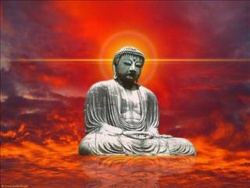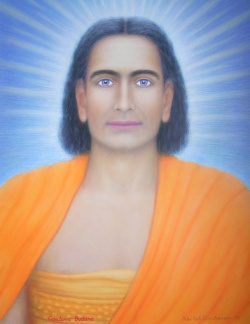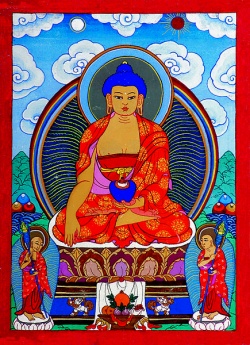Difference between revisions of "Śūnyavāda"
(Created page with "<poem> SUNN, a {{Wiki|Punjabi}} form of the Sanskrit term śūnya (Pālī, sunna), is derived from the root śvi which is connected with the root śū; both t...") |
|||
| (10 intermediate revisions by 3 users not shown) | |||
| Line 1: | Line 1: | ||
| − | + | [[File:1905h.jpg|thumb|250px|]] | |
| − | + | ||
| + | :: [[SUNN]], a {{Wiki|Punjabi}} [[form]] of the [[Sanskrit]] term [[śūnya]] ([[Pālī]], [[sunna]]), is derived from the [[root]] [[śvi]] which is connected with the [[root]] [[śū]]; both these [[roots]] mean '[[to swell]]', '[[to expand]]' or '[[to increase]]'. | ||
| + | |||
| + | From the {{Wiki|etymological}} standpoint the term [[śūnya]] is often used in the [[sense]] of 'zero' or 'cipher' ({{Wiki|Arabic}}, sifr), a [[symbol]] of naught. However, 'zero' again, when used by a {{Wiki|mathematician}} with a figure, increases the value of that figure ten times. | ||
| + | |||
| + | :: The [[word]] [[śūnya]] belongs to the [[religious]] and [[philosophical]] {{Wiki|terminology}} of [[India]]. | ||
| + | |||
| + | Its meaning has to be explored in [[relation]] to two other {{Wiki|cognate}} words, viz. [[śūnyatā]] and [[śūnyavāda]]. | ||
| + | |||
| + | The words [[śūnya]] and [[[[śūnyatā]]]] have [[attained]] widespread currency chiefly through the agency of [[Buddhist]] {{Wiki|literature}}: while '[[śūnyavāda]]' is the [[name]] given one of the systems of [[Buddhistic]] [[thought]], the [[word]] [[śūnya]] means [[void]], [[empty]], a lonely place or [[solitude]]. | ||
| + | |||
| + | The [[word]] [[śūnyatā]] means [[voidness]], [[emptiness]], [[vacuity]] or [[nothingness]]. | ||
| + | |||
| + | The [[word]] '[[śūnyavāda]]' has been translated as 'the ism of [[void]]' or 'the [[doctrine]] of [[empty]]'. | ||
| + | |||
| + | The barrenness of this translation is [[inherent]] in the pejorative force which gave [[birth]] to this [[name]] in anti-[[Buddhist]] circles. | ||
| + | |||
| + | It is on the authority of anti-[[Buddhist]] {{Wiki|Brahmanical}} sources that {{Wiki|Monier-Williams}} described '[[śūnyavāda]]' in 1899 as 'the ([[Buddhist]]) [[doctrine]] of the [[non-existence]] (of any [[spirit]] either supreme or [[human]]), [[Buddhism]], {{Wiki|atheism}}.' | ||
| + | [[File:2189.jpg|thumb|250px|]] | ||
| + | |||
| + | :: As a {{Wiki|matter}} of fact, it is in the work of the {{Wiki|Brahmanical}} {{Wiki|theologians}}, such as [[Kumārilabhaṭṭa]] and [[Śaṅkarāchārya]], that the [[name]] '[[Śūnyavāda]]' is employed for the [[Mādhyamika]] School of [[Buddhist philosophy]]. | ||
| + | |||
| + | The [[Buddhist]] [[philosophers]] themselves have never used or approved this {{Wiki|nomenclature}}. | ||
| + | |||
| + | :: At numerous places in the [[Pālī]] [[scriptures]] it is stated that the [[world]] ([[loka]]) is [[empty]] ([[śūnya]]); it is [[empty]] of [[self]] ([[ātman]]) and [[empty]] of anything belonging to [[self]]. | ||
| + | |||
| + | There is [[nothing]] in the [[world]] with which one could identify one's [[self]], or of which one could say, 'this is my [[self]].' | ||
| + | |||
| + | A whole section of the [[Paṭisambhidāmagga]] is entitled '{{Wiki|discourse}} on the [[void]].' | ||
| + | |||
| + | In this section twenty-five kinds of [[void]] are enumerated. | ||
| + | |||
| + | The [[Mahāyānasūtras]] and [[Śāstras]] elaborated these teachings concerning [[śūnya]] and [[śūnyatā]] and developed a {{Wiki|soteriological}} technique based on the [[philosophy]] of [[Emptiness]]. | ||
| + | |||
| + | A class of [[Buddhist]] [[Sanskrit]] {{Wiki|literature}} consisting of the [[Prajñāpāramitāsūtras]] is devoted to the [[exposition]] of [[emptiness]]. | ||
| + | |||
| + | |||
| + | |||
| + | :: The [[Prajñāpāramitāsūtras]] teach that [[śūnyatā]] is the [[nature]] of all [[phenomenal]] things or entities called [[dharmas]]. | ||
| + | |||
| + | Things are [[empty]] ([[śūnya]]) because they are [[conditioned]]; they are [[conditioned]] because they depend on a multiplicity of [[causes]]. [[Nothing]] is, uncaused, therefore [[nothing]] is free from [[śūnya]], [[emptiness]]. | ||
| + | |||
| + | The [[dependence]] of entities on [[causes]] and [[conditions]] constitutes their [[emptiness]]. | ||
| + | |||
| + | All things or [[phenomena]] are [[subject]] to [[dependent origination]] (pratītyāsamutapāda); therefore all [[phenomena]] are characterized by [[emptiness]] ([[śūnyatā]]). | ||
| + | |||
| + | This fact is called [[dharma]] [[śūnyatā]], the [[emptiness]] of [[dharmas]] or the [[phenomena]]. | ||
| + | [[File:Buddha-pict.jpg|thumb|250px|]] | ||
| + | |||
| + | |||
| + | :: [[Nāgārjuna]] who flourished in the first century AD is the main originator of the [[doctrine]] of [[śūnya]] which in fact offers the critique of all the [[philosophies]]. | ||
| + | |||
| + | [[Going beyond]] the viewpoints of [[asti]] (is) [[nāsti]] (is not) about the Supreme [[Truth]], the [[śūnyavādins]] adopt a [[dialectical]] method which seeks to abolish all viewpoint but, side by side, they do not claim to have [[śūnyavād]], a viewpoint in itself. | ||
| + | |||
| + | The [[aim]] of this [[teaching]] is {{Wiki|soteriological}} and not [[philosophical]]. | ||
| + | |||
| + | |||
| + | |||
| + | :: [[Śūnya]] means that all the [[objects]] of the [[world]] are lacking in their '[[own]] [[nature]]' ([[svabhāva]] [[dharma]] or '[[self]] [[existence]]' ([[ātmabhāva]]) ; that is to say, the [[dharmas]] are without an [[essence]] of inward [[nature]] of their [[own]] and are without [[self]]. | ||
| + | |||
| + | The [[absence of own-nature]] ([[niḥsvabhāvatā]]) and the absence of [[self]] ([[nairātmya]]) are thus synonyms of [[emptiness]]. | ||
| + | |||
| + | Not only the persons are characterized by [[emptiness]] ([[pudgala-nairātmya]]) but also the things are characterized by [[emptiness]] ([[dharma-nairātmya]]). | ||
| + | |||
| + | He who realizes this twofold [[emptiness]] ([[śūnyatā]]) attains [[transcendental]] [[wisdom]] ([[prajñāparamitā]]). | ||
| + | |||
| + | |||
| + | |||
| + | :: The [[Prajñāpāramitasūtras]] have employed the [[master]] [[symbol]] [[śūnyatā]] not only for the [[phenomenal]] things but also for the [[Absolute]]. | ||
| + | |||
| + | The [[phenomenal]] things are called [[śūnya]] because they are dependent on [[causes]] and [[conditions]]. | ||
| + | |||
| + | The [[Absolute]] is called [[śūnya]] because it is devoid of {{Wiki|distinctions}} and discriminations. [[Śūnyatā]] demonstrates the [[ultimate]] unreality of entities and the unseekability of the [[Absolute]] which {{Wiki|transcends}} [[thought]] and [[speech]]. | ||
| + | [[File:Buddha-painting.jpg|thumb|250px|]] | ||
| + | |||
| + | |||
| + | |||
| + | :: The {{Wiki|concept}} of [[Śūnya]] ([[sunn]]) was transmitted by the [[Siddhas]] and the Nāthas to the saint-poets of {{Wiki|medieval}} {{Wiki|Vaiṣṇavism}}. | ||
| + | |||
| + | In the works of the {{Wiki|Sikh}} Gurūs we find the last phase of the [[development]] of the {{Wiki|concept}} of [[śūnya]] outside [[Buddhism]]. | ||
| + | |||
| + | The {{Wiki|Sikh}} Gurūs have used the words [[sunn]], [[sunn]] [[kalā]], [[anahat-sunn]] and [[sunn-samādhī]] numerous times in their [[religious]] compositions. | ||
| + | |||
| + | A careful analysis of the use of these key-terms in the {{Wiki|Sikh}} [[canon]] shows that their meaning is, in most cases, different from that found in [[Buddhism]]. | ||
| + | |||
| + | In one case, however, there seems to be a continuity of the [[word]] and meaning from the [[time]] of the [[Buddhist]] [[Sutras]] to that of the hymns sung by the Gurūs. | ||
| + | |||
| + | This continuity is found in those cases in which [[sunn]] or [[śūnya]] is employed as a [[symbol]] of the [[Absolute]]. | ||
| + | |||
| + | |||
| + | |||
| + | [[Thus]], for example, it is said that when one is [[awakened]] to the [[teaching]] of the Gurū, one merges into the [[Void]] ([[sunn]] samāiā) even while alive ---jīvat sunni samāniā gur sākhī jāgī (GG, 857). | ||
| + | |||
| + | |||
| + | Of course the {{Wiki|concept}} of the [[Absolute]] in {{Wiki|Sikhism}} differs from that in the [[Madhyamika]], but there can be no [[doubt]] that the [[Absolute]] is called [[sunn]] because it is devoid of [[duality]] and {{Wiki|discrimination}}. | ||
| + | |||
| + | This negative {{Wiki|structure}} in [[speech]] with regard to the [[Reality]] is the basic [[function]] of the [[symbol]] [[sunn]]. | ||
| + | |||
| + | All positive descriptions imply limitation and [[determination]]. | ||
| + | |||
| + | |||
| + | The [[word]] [[sunn]] declares that the [[Truth]] is beyond limitations and [[determinations]]. [[Emptiness]] of [[Buddhism]] means 'no [[doctrine]] about [[Truth]]'; [[sunn]] in {{Wiki|Sikhism}} means 'no {{Wiki|conception}} about the [[Inconceivable]].' | ||
| + | |||
| + | |||
| + | :: An important feature of the {{Wiki|conception}} of the [[Void]] in {{Wiki|Sikhism}} is that it can be [[realized]] through [[transcendental]] [[devotion]] (nām) which consists in the [[constant]] [[mindfulness]] of the [[Divine]] (simaran). | ||
| + | |||
| + | |||
| + | This feature brings in many positive [[elements]] as a {{Wiki|matter}} of course and consequently the {{Wiki|ecstatic}} [[experience]] of the [[Divine]] is characterized by positive [[attributes]]. Nevertheless, these positive [[attributes]] do not exhaust the Innate [[state]] of [[sahaj]] or the [[Void]] ([[sunn]]). | ||
| + | |||
| + | Kabīr uses [[sunn]] in the [[sense]] of [[space]], finite as well as [[infinite]], i.e. ghaṭākāsh and mahākāsh. | ||
| + | |||
| + | The three [[lokas]] enveloping [[śūnya]] is [[nothing]] but [[Brahman]] with [[māyā]] but the fourth [[śūnya]] about which {{Wiki|Gurū Nānak}} stresses more is [[pure]] [[Brahman]] who is nirākār and [[nirguṇa]]. | ||
| + | |||
| + | |||
| + | In Rāg Mārū, {{Wiki|Gurū Nānak}} defines [[sunn]] as the creative [[power]] of the Almighty--pauṇu pāṇī sunnai te sāje (GG, 1037). | ||
| + | |||
| + | The [[sense]] of [[nāda]] has also been exacted from the term [[sunn]] in the Sidha Gosṭi where {{Wiki|Gurū Nānak}} says: "nau sar subhar dasavai pūre tah anahat [[sunn]] vajāvahī tūre-- after filling up the nine pitchers with [[love]], through the tenth gate the entry is made; the anahat [[śūnya]] in the [[form]] of melodies is [[realized]]" (GG, 943). | ||
| + | |||
| + | The term [[sunn]] in the Gurū Granth Sāhib is thus used in a variety of [[senses]], of which predominantly are Brahmaṇ with and without [[māyā]], the creation, the [[power]] of [[Brahman]] and [[nāda]]. | ||
| + | |||
| + | |||
| + | |||
| + | :: Here the unstruck [[sound]]; inaccessible to {{Wiki|ears}}, goes on as 'the [[music]] of [[spheres]]' as it were, and the wonderful (acharaj) [[bewilderment]] (bismād) [[characteristic]] of it cannot be described (kahanu na jāi). | ||
| + | |||
| + | [[Peace]] (śāntī), [[bliss]] ([[sukh]], [[ananda]]) and {{Wiki|satiety}} ([[santokhu]]) are [[attained]] in this [[state]]. | ||
| − | + | But here in the [[ultimate]] [[state]] there is neither he who attains these things nor he who listens to their description ; | |
| − | + | [[void]] has gone to [[Void]], [[emptiness]] had merged into [[Emptiness]]. | |
| − | + | He says: [[sunnahī sunnu miliā samdarsī]]--- the {{Wiki|individual}} [[spirit]] has joined the supreme [[spirit]] (GG, 1103). | |
| − | |||
| − | |||
| − | + | :: [[Bhāī Gurdās]], explicator of [[Gurbāṇī]], uses [[śūnya]] in the [[sense]] of [[cosmic]] [[silence]] ---[[ditī bāngi nivāji kāri sunni samāni hoā jahānā]] (1.35). | |
| − | + | As in the [[Haṭhayogapradīpikā]], {{Wiki|Gurū Nānak}} also accepts that [[śūnya]] is within, [[śūnya]] is without and the three [[lokas]] are also imbued with [[śūnya]]. | |
| − | + | Whosoever becomes [[the knower]] of the [[truth]], [[śūnya]], goes beyond [[sins]] and [[virtues]]. | |
| − | + | He {{Wiki|transcends}} both error and [[excellence]]. | |
| − | |||
| − | + | :: It may be observed that like the [[word]] [[Nirvāṇa]], the [[word]] [[śūnya]] also underwent a [[gradual]] process of [[transformation]] in its meaning and use in the {{Wiki|literature}} of {{Wiki|medieval}} [[India]]. | |
| − | + | The [[Mādhyamika]] {{Wiki|conception}} of [[śūnyatā]] was almost completely changed in [[Nāthapantha]], [[Kabīrpantha]] and {{Wiki|Sikhism}}. | |
BIBLIOGRAPHY | BIBLIOGRAPHY | ||
| − | + | <poem> | |
| − | {{Wiki|Monier Williams}}, [[Sanskrit]] English Dictionary | + | {{Wiki|Monier Williams}}, [[Sanskrit]] English {{Wiki|Dictionary}} |
| − | Dutt, N., Pancavimsatisāhasrika Prajnaparamitasutra. {{Wiki|London}}, 1934 | + | Dutt, N., [[Pancavimsatisāhasrika Prajnaparamitasutra]]. {{Wiki|London}}, 1934 |
| − | Robinson, Richard H., Early [[Madhyamika]] in [[India]] and [[China]]. Wisconsin, 1967 | + | [[Robinson, Richard H]]., Early [[Madhyamika]] in [[India]] and [[China]]. Wisconsin, 1967 |
Śabadārth Srī Gurū Granth Sāhib. Amritsar, 1969 | Śabadārth Srī Gurū Granth Sāhib. Amritsar, 1969 | ||
| − | Dasgupta, Surendranath, [[Indian]] {{Wiki|Idealism}}. {{Wiki|Cambridge}}, 1961 | + | [[Dasgupta]], Surendranath, [[Indian]] {{Wiki|Idealism}}. {{Wiki|Cambridge}}, 1961 |
Kabīrgranthāvalī | Kabīrgranthāvalī | ||
| − | Jodh Siṅgh, The [[Religious]] [[Philosophy]] of Gurū Nānak. Delhi, 1989 | + | Jodh Siṅgh, The [[Religious]] [[Philosophy]] of {{Wiki|Gurū Nānak}}. {{Wiki|Delhi}}, 1989 |
</poem> | </poem> | ||
{{R}} | {{R}} | ||
[http://www.learnpunjabi.org/eos/SUNN.html www.learnpunjabi.org] | [http://www.learnpunjabi.org/eos/SUNN.html www.learnpunjabi.org] | ||
[[Category:Śūnyatā]] | [[Category:Śūnyatā]] | ||
Latest revision as of 06:15, 14 April 2015
From the etymological standpoint the term śūnya is often used in the sense of 'zero' or 'cipher' (Arabic, sifr), a symbol of naught. However, 'zero' again, when used by a mathematician with a figure, increases the value of that figure ten times.
- The word śūnya belongs to the religious and philosophical terminology of India.
Its meaning has to be explored in relation to two other cognate words, viz. śūnyatā and śūnyavāda.
The words śūnya and [[śūnyatā]] have attained widespread currency chiefly through the agency of Buddhist literature: while 'śūnyavāda' is the name given one of the systems of Buddhistic thought, the word śūnya means void, empty, a lonely place or solitude.
The word śūnyatā means voidness, emptiness, vacuity or nothingness.
The word 'śūnyavāda' has been translated as 'the ism of void' or 'the doctrine of empty'.
The barrenness of this translation is inherent in the pejorative force which gave birth to this name in anti-Buddhist circles.
It is on the authority of anti-Buddhist Brahmanical sources that Monier-Williams described 'śūnyavāda' in 1899 as 'the (Buddhist) doctrine of the non-existence (of any spirit either supreme or human), Buddhism, atheism.'
- As a matter of fact, it is in the work of the Brahmanical theologians, such as Kumārilabhaṭṭa and Śaṅkarāchārya, that the name 'Śūnyavāda' is employed for the Mādhyamika School of Buddhist philosophy.
The Buddhist philosophers themselves have never used or approved this nomenclature.
There is nothing in the world with which one could identify one's self, or of which one could say, 'this is my self.'
A whole section of the Paṭisambhidāmagga is entitled 'discourse on the void.'
In this section twenty-five kinds of void are enumerated.
The Mahāyānasūtras and Śāstras elaborated these teachings concerning śūnya and śūnyatā and developed a soteriological technique based on the philosophy of Emptiness.
A class of Buddhist Sanskrit literature consisting of the Prajñāpāramitāsūtras is devoted to the exposition of emptiness.
- The Prajñāpāramitāsūtras teach that śūnyatā is the nature of all phenomenal things or entities called dharmas.
Things are empty (śūnya) because they are conditioned; they are conditioned because they depend on a multiplicity of causes. Nothing is, uncaused, therefore nothing is free from śūnya, emptiness.
The dependence of entities on causes and conditions constitutes their emptiness.
All things or phenomena are subject to dependent origination (pratītyāsamutapāda); therefore all phenomena are characterized by emptiness (śūnyatā).
This fact is called dharma śūnyatā, the emptiness of dharmas or the phenomena.
- Nāgārjuna who flourished in the first century AD is the main originator of the doctrine of śūnya which in fact offers the critique of all the philosophies.
Going beyond the viewpoints of asti (is) nāsti (is not) about the Supreme Truth, the śūnyavādins adopt a dialectical method which seeks to abolish all viewpoint but, side by side, they do not claim to have śūnyavād, a viewpoint in itself.
The aim of this teaching is soteriological and not philosophical.
The absence of own-nature (niḥsvabhāvatā) and the absence of self (nairātmya) are thus synonyms of emptiness.
Not only the persons are characterized by emptiness (pudgala-nairātmya) but also the things are characterized by emptiness (dharma-nairātmya).
He who realizes this twofold emptiness (śūnyatā) attains transcendental wisdom (prajñāparamitā).
- The Prajñāpāramitasūtras have employed the master symbol śūnyatā not only for the phenomenal things but also for the Absolute.
The phenomenal things are called śūnya because they are dependent on causes and conditions.
The Absolute is called śūnya because it is devoid of distinctions and discriminations. Śūnyatā demonstrates the ultimate unreality of entities and the unseekability of the Absolute which transcends thought and speech.
In the works of the Sikh Gurūs we find the last phase of the development of the concept of śūnya outside Buddhism.
The Sikh Gurūs have used the words sunn, sunn kalā, anahat-sunn and sunn-samādhī numerous times in their religious compositions.
A careful analysis of the use of these key-terms in the Sikh canon shows that their meaning is, in most cases, different from that found in Buddhism.
In one case, however, there seems to be a continuity of the word and meaning from the time of the Buddhist Sutras to that of the hymns sung by the Gurūs.
This continuity is found in those cases in which sunn or śūnya is employed as a symbol of the Absolute.
Thus, for example, it is said that when one is awakened to the teaching of the Gurū, one merges into the Void (sunn samāiā) even while alive ---jīvat sunni samāniā gur sākhī jāgī (GG, 857).
Of course the concept of the Absolute in Sikhism differs from that in the Madhyamika, but there can be no doubt that the Absolute is called sunn because it is devoid of duality and discrimination.
This negative structure in speech with regard to the Reality is the basic function of the symbol sunn.
All positive descriptions imply limitation and determination.
The word sunn declares that the Truth is beyond limitations and determinations. Emptiness of Buddhism means 'no doctrine about Truth'; sunn in Sikhism means 'no conception about the Inconceivable.'
- An important feature of the conception of the Void in Sikhism is that it can be realized through transcendental devotion (nām) which consists in the constant mindfulness of the Divine (simaran).
This feature brings in many positive elements as a matter of course and consequently the ecstatic experience of the Divine is characterized by positive attributes. Nevertheless, these positive attributes do not exhaust the Innate state of sahaj or the Void (sunn).
Kabīr uses sunn in the sense of space, finite as well as infinite, i.e. ghaṭākāsh and mahākāsh.
The three lokas enveloping śūnya is nothing but Brahman with māyā but the fourth śūnya about which Gurū Nānak stresses more is pure Brahman who is nirākār and nirguṇa.
In Rāg Mārū, Gurū Nānak defines sunn as the creative power of the Almighty--pauṇu pāṇī sunnai te sāje (GG, 1037).
The sense of nāda has also been exacted from the term sunn in the Sidha Gosṭi where Gurū Nānak says: "nau sar subhar dasavai pūre tah anahat sunn vajāvahī tūre-- after filling up the nine pitchers with love, through the tenth gate the entry is made; the anahat śūnya in the form of melodies is realized" (GG, 943).
The term sunn in the Gurū Granth Sāhib is thus used in a variety of senses, of which predominantly are Brahmaṇ with and without māyā, the creation, the power of Brahman and nāda.
- Here the unstruck sound; inaccessible to ears, goes on as 'the music of spheres' as it were, and the wonderful (acharaj) bewilderment (bismād) characteristic of it cannot be described (kahanu na jāi).
Peace (śāntī), bliss (sukh, ananda) and satiety (santokhu) are attained in this state.
But here in the ultimate state there is neither he who attains these things nor he who listens to their description ;
void has gone to Void, emptiness had merged into Emptiness.
He says: sunnahī sunnu miliā samdarsī--- the individual spirit has joined the supreme spirit (GG, 1103).
- Bhāī Gurdās, explicator of Gurbāṇī, uses śūnya in the sense of cosmic silence ---ditī bāngi nivāji kāri sunni samāni hoā jahānā (1.35).
As in the Haṭhayogapradīpikā, Gurū Nānak also accepts that śūnya is within, śūnya is without and the three lokas are also imbued with śūnya.
Whosoever becomes the knower of the truth, śūnya, goes beyond sins and virtues.
He transcends both error and excellence.
- It may be observed that like the word Nirvāṇa, the word śūnya also underwent a gradual process of transformation in its meaning and use in the literature of medieval India.
The Mādhyamika conception of śūnyatā was almost completely changed in Nāthapantha, Kabīrpantha and Sikhism.
BIBLIOGRAPHY
Monier Williams, Sanskrit English Dictionary
Dutt, N., Pancavimsatisāhasrika Prajnaparamitasutra. London, 1934
Robinson, Richard H., Early Madhyamika in India and China. Wisconsin, 1967
Śabadārth Srī Gurū Granth Sāhib. Amritsar, 1969
Dasgupta, Surendranath, Indian Idealism. Cambridge, 1961
Kabīrgranthāvalī
Jodh Siṅgh, The Religious Philosophy of Gurū Nānak. Delhi, 1989



